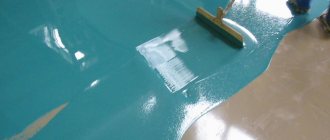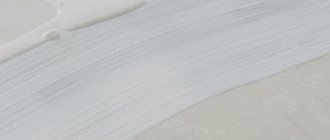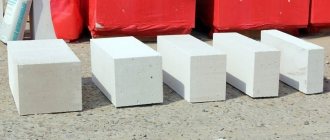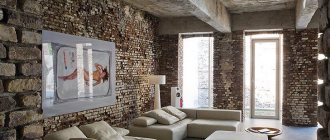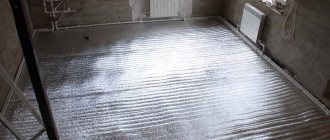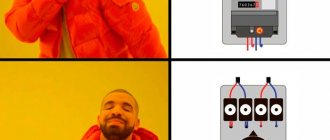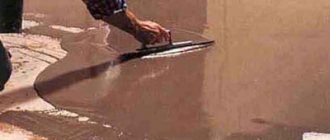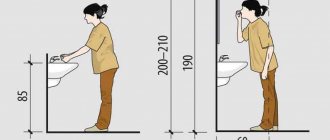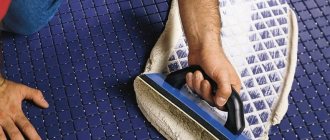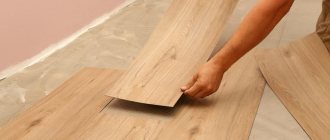How to make self-leveling floors for tiles
Self-leveling flooring is one of the best materials for tiles, as it is characterized by high strength and evenness of the resulting base. It does not shrink and is protected from cracking and geometry changes. It is important to achieve a level surface before laying tiles. The optimal height difference is up to 2 mm per 1 linear meter of surface.
Self-leveling flooring has a number of advantages:
- use as a finishing coating;
- a good solution if a solid foundation is required;
- high strength characteristics;
- not susceptible to external factors;
- withstands severe loads;
- Ideal for ceramic tiles;
- minimum drying time.
Note! Self-leveling flooring is suitable for application on a solid base. But it is better to pre-treat it with a primer to prevent the material from flowing into microcracks in the base.
Answers (7)
The disadvantage of cement screed is the fact that in order to comply with the required strength
READ MORE: Primer before laying ceramic tiles in the bathroom
characteristics, its thickness must be at least 3 cm. Therefore
I bet you that the old tiles do not hold firmly everywhere, remove the tiles. Pouring floors, especially in such an area, is not for an amateur. Find yourself an experienced “commander” for this. Otherwise, you know, the first damn thing is lumpy. Good luck!
Check the horizontal level of the floor; due to the old tiles, the filling level will rise and material consumption will increase. If the horizon is not important to you, check each tile. If it is durable, you can fill it, just buy a good self-leveling screed and read the instructions on the bags (the thickness of the filling is important)
What if you fill the places where there are no tiles with putty? Then floor consumption should decrease. I want to take IVSIL Tie Rod III floor and its floor leveler to cover large differences.
You will need a laser level (to find out where the differences are). Dismantle the tile - God forbid, it will become loose under your self-leveling floor! Again, if you don't have experience installing self-leveling floors, I don't recommend doing it yourself. Correcting errors can take a lot of time and money.
Which self-leveling floor is better to choose for tiles?
There are two main options on sale - cement and gypsum self-leveling floors. Not all substrates are suitable for installation under tiles. The best choice would be a universal composition characterized by increased moisture-resistant qualities. In this case, there must be high compressive strength. If you plan to install it in a dry room without changes in humidity, you can choose a gypsum mixture.
Depending on your goals, you can choose the following mixture options:
| Thin-layer | They are usually used for decorative purposes as a finishing coating. But mixtures are offered that significantly increase mechanical stability. The thickness of the composition is offered from 1 to 5 mm. |
| Self-leveling | The thickness of the material does not exceed 2 cm. A self-leveling floor does not require serious effort, since the composition is almost independently distributed over the surface. The finished coating is so durable that it can be used in non-residential buildings without heating. |
| Highly filled | This material allows you to obtain a layer from 2 to 5 cm. Thanks to the use of inexpensive components, the cost of self-leveling flooring will be insignificant. |
Most often, self-leveling mixtures are used for domestic purposes. They are not difficult to use and do not require much effort when installing. It uses simple technology without expensive equipment.
Thickness at low temperatures
If you want to make a self-leveling floor yourself, step-by-step instructions will help you do this. But it is important to look at individual cases of work, such as in the case of constant low temperatures. It is very important to choose the appropriate mixture for the job, which is based on methyl methacrylate resins. They also contain special components that help resist frost. In order for the self-leveling floor to actively withstand low temperatures, its thickness should be within 5-7 mm, no less. Refrigerators are an excellent option for installing such a floor.
Self-leveling flooring technology
Leveling the floor before laying tiles requires preliminary preparation of the surface. It is important to choose the appropriate material, prepare a flat concrete base, and prime the surface.
The following instructions are used:
- Immediately after preparing the mixture, pour it onto the floor surface. Fill starting from the far corner of the room. Ensure continuous filling of the composition. For this reason, it is better to work together. The maximum break is 20 minutes.
- Level the solution to the desired level. It should be the same throughout the room.
- Use an aerobic roller to roll the mortar layer after leveling. They need to work for at least 10 minutes without removing it from the solution.
Mix the solution
Pour onto prepared surface
Level with a needle roller
Done
Dmitry Novoselov
Author and expert of our site. He regularly shares his wealth of experience in construction and renovation.
Ask a Question
When working, use special shoes or spiked boot mounts. They are of sufficient height so as not to damage the surface being treated.
If everything is done correctly, the result is noticeable almost immediately. The surface is smooth, without any damage or uneven areas. Further work with the tiles can be continued after the material has completely dried, which is indicated on the packaging with the mixture.
Acrylic-cement bulk mixtures
Having already become a classic, the mixture is suitable for those areas where the loads are extremely high. The coating is relevant for wet industries, various warehouses, and garages. As for thickness, to obtain high wear resistance characteristics, the layer is made from 10 to 20 mm. The material has excellent resistance to various types of chemicals, and is also durable, but subject to a minimum thickness.
Thickness of self-leveling floor under tiles
Before starting work, calculate the material costs. The cost of repairs will largely depend on this. The main influencing factor is the thickness of the layer. It should be selected taking into account a number of features:
| Minimum thickness | It is taken into account in accordance with the recommendations on the packaging left by the manufacturer. On average it is up to 1 mm. |
| Load level | The vibration effect and the degree of traffic in the room are taken into account. If high strength and wear resistance are required, you will have to order more material. |
| Surface curvature | The fill layer will be thicker for non-standard rooms. |
For an ordinary apartment or house, a large thickness (about 5 mm) is not required. It is important that the concrete base is level. Waterproofing compounds are also used in the bathroom to ensure complete safety against leaks. The thickness of the highly filled layer is on average 8 mm.
Filling algorithm taking into account recommended thicknesses
A more detailed analysis of the rules for choosing layer thicknesses can be done using the example of creating a decorative polymer floor with a pattern on a special film under the following basic conditions: an uneven cement-sand base with a height difference of 5...20 mm and average requirements for the performance characteristics of the floor. The layout of the layers is shown in the illustration.
In this case, the total thickness of the self-leveling floor layer (meaning both the leveling mixture and the finishing polymer composition on top of the decorative image) will be 25 + 5 = 30 mm. First, the base is prepared and primed (the process is discussed in detail in the article “Self-leveling floor: instructions for pouring it yourself”), then preliminary leveling is arranged using a suitable mineral (cement or cement-gypsum) mixture. Material consumption can be calculated using an online calculator. After the first layer has completely cured, you can pour the second layer of self-leveling floor (transparent polymer), after laying down a film with a decorative pattern.
The step-by-step process of pouring a “three-dimensional” self-leveling floor is discussed in more detail in the video.
How long does it take for a self-leveling floor to dry?
To do the job correctly with your own hands, it is important to know the drying period of the bulk mixture. The solution begins to set after 15-20 minutes. After this, it takes another 8 to 10 hours to gain strength. During this period, it is allowed to step on the surface, although it is not yet advisable to do this.
Manufacturers indicate an average drying period of 1 to 3 days. The exact period depends on the height of the coating and the total area of the room. After the drying process is complete, you can begin laying ceramic tiles. If the mixture is prepared correctly, there will be no difficulties during the drying period. A thin layer coating in most cases dries within 24 hours.
Subtle technologies
Before you make a self-leveling floor, you should focus on its specific version. At the same time, everyone should understand that every millimeter is significant. Polymer coatings have especially advanced in this direction, where even 1-2 mm will be enough to withstand certain surface loads. True, not everyone can make such a thin layer efficiently. There will even be small recesses in the screed where the solution for the self-leveling floor falls.
In this case, it is important to know how self-leveling floors are made. After all, a thin layer is typical for a finishing coating. When it exists, there will be some intermediate ones. It is the base layer that will smooth out all the unevenness of the concrete or cement screed and the base itself. These mixtures are also not expensive due to their unique composition: gypsum, sand, cement, plasticizers. Polymers are almost completely absent, and if they are present in small amounts, it is only to impart strength to the surface.
The maximum thickness of the self-leveling floor, or rather the base layer, can reach 80 mm. If the mixture also contained polymers, then their final price would be exorbitant. If you have to make an even larger screed, then it is best to fill it with other components, such as expanded clay, and only then proceed further. Cheapness also encourages their replacement with semi-dry screeds. The surface becomes very smooth and can be used under any floor covering. Base layers cannot be used as a finishing coat, as they wear out very easily and are less durable in use.
Work can be carried out using quick-hardening mixtures. In this case, special attention is paid to beacons and their placement. If this is not controlled, then the thickness parameters from the manufacturer will be violated.
How to install self-leveling floor
You will make self-leveling floors correctly if you dilute the composition in accordance with the manufacturer's requirements. To prepare the mixture, pour the powder from the bag into a specially prepared container. The most convenient option is a large bucket designed for construction work.
Add enough water to the mixture. At the same time, as you fall asleep, it is important to stir simultaneously. It is more convenient to perform this work in parallel, for which you will need an assistant.
It is important to take the ratio of water and dry composition in strict accordance with the manufacturer's recommendations. Increased water may disrupt the hydration process. In this case, strength characteristics and resistance to heavy loads are lost. If it is deficient, the composition will be too dense and will not be distributed correctly over the surface.
The most important component is following the recommendations. The result is the following:
- It is better to stir the mixture using a puncher with a special attachment, as the fastest possible effect is obtained;
- the finished composition obtains a creamy and homogeneous texture;
- The mixture is completely ready for pouring after repeated mixing.
Lay the self-leveling floor before finishing the walls and ceiling. This will avoid the need to clean surfaces after completion of work. If wallpaper or painting is chosen as wall decoration, you will have to completely redo the decorative layer.
Main characteristics of self-leveling compounds
According to Russian building codes and regulations, the cross-section of the screed must meet the parameters of 20-150 mm. Mobile or highly mobile dry compositions differ:
- viscosity. Contains gypsum and cement;
- filler The composition contains perlite and quartz sand;
- additional additives. Components with modifying and plasticizing characteristics, additives contribute to more convenient laying of the material, improve the spreadability of the solution, speed up the drying time, and reduce the shrinkage rate.
Self-leveling floors also include decorative finishing polymer mixtures. The compositions represent a series of household 3D and industrial protective coatings, which in composition and properties are similar to varnish for wooden and stone surfaces.
Photo: 3D self-leveling floor
Contains film-forming components based on high-strength resinous substances:
- acrylic;
- polyurethane;
- epoxy.
Apply with a roller or spatula onto a previously prepared mineral base. After hardening, the result is a varnish coating that is extremely resistant to abrasive, impact and other physical negative loads.
Do you need a self-leveling floor under tiles?
Whether it is necessary to make self-leveling floors before installation is up to you to decide. This will provide high strength and protect the base from possible damage. This is especially important if a significant load on the floor is planned - installation of heavy furniture, high traffic flow of the room. When done correctly, the result is a reliable and durable coating.
Another possible method is to pour a concrete base along the beacons. In this case, it is difficult to obtain a perfectly flat surface, since the mixture will not be leveled well. This increases the drying time of the material. In many cases it reaches up to 4 weeks.
A positive property of self-leveling floors is the minimum amount of preparatory work. They do not require large financial and labor costs. Simply prepare the required amount of mixture and apply to the surface. You can start laying tiles within a few days. It is performed using standard technology.
This way, you can level the floor yourself before laying ceramic tiles. To do this, select a high-quality mixture for self-leveling flooring. It will provide high strength and reliability for many years. The tile holds well on the surface, does not crack or shift under load.
Video description
In the video, the master will tell you how to properly prepare a room for a self-leveling floor, how much mortar is needed per square meter and how to calculate the required number of bags of self-leveling mixture:
And at the end, some tips from professionals on how to prepare the mortar:
- The mixture must be kneaded in such quantity that it can be distributed within 20 minutes.
- If you dilute the dry composition with much more water than indicated on the packaging, this will naturally lead to a reduction in material consumption. But the quality of the coating will be seriously affected.
- All work is carried out at a room temperature not lower than +10 degrees Celsius.
- Mixing the solution is carried out in two stages, with a break between them of 5 minutes. Let the mixture settle.
Mixing the solution Source remstd.ru
Optimal layer thickness for self-leveling compounds
Polymer floors are quite expensive. At the same time, the thickness of the coating can be very small. Thus, polyurethane-based compositions make it possible to make layers up to 2.5 mm thick, which is optimal. If it is necessary to give the floor a gloss or paint the surface in different colors, apply only 0.3 mm of the composition. The maximum for this coating is 5 mm. You can do more, but it’s more expensive and doesn’t make much sense.
As for epoxy-based compounds, the optimal value here is also 2.5 mm. This thickness allows you to obtain sufficient strength characteristics without the floor being fragile.
Methyl methacrylate or quick-hardening mixtures can also be used with small thicknesses. But it's not worth saving here. For a high-quality coating, the layer must be at least 8 mm.
Advised by professionals
In order to obtain the highest quality surface at an affordable price, experts use some techniques.
So, if the base base is not too crooked to purchase medium or basic bulk compositions, but not so smooth as to get away with just a finishing coating, the situation can be corrected. You just need to sand the surface using a sanding machine. This will smooth out unevenness and save on materials.
In order not to purchase primer compounds, you can make them yourself from a small amount of dry compounds for self-leveling floors. The mixture is diluted and then applied to the base with a roller. When the product has dried, you can pour the finishing floor.
